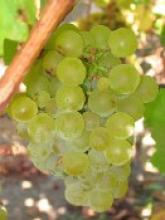I will confess that until very recently, the only things I knew about Sauvignon Blanc were that it was one of the parent grapes of Cabernet Sauvignon, that it was a green-skinned white wine grape, and that it was a frequent ingredient of several of the Washington white blends I've tried and enjoyed. The name Sauvignon or "savage" refers to the grape's ancestry as "wild" stock; it's a native, so to speak, of western France's Loire valley and Bordeaux areas. It is, as far as we can tell, an indigenous grape that spontaneously appeared in southwestern France before the middle ages. Sauvignon blanc has since been carefully cultivated just about everywhere wine grapes are grown. It's used in a variety of blends as well as for dessert wines like Chateau Y'Quem Sauternes, made after the very ripe grapes have developed Botrytis cinerea or "Noble Rot."
Sauvignon Blanc wines from France's Loire valley are often given names like Sancerre and Pouilly-Fumé; the use of fumé is a reference to the thick, almost smokey morning fog that rises from the Loire in the traditional growing area for Sauvignon Blanc in France. We can thank Robert Mondavi for popularizing Fumé Blanc as a name for Sauvignon Blanc. Mondavi borrowed the name to label his dry Sauvignon Blancs, and the wine industry, particularly in California, and the Pacific Northwest, ran with it. Many wineries use the Fumé Blanc label for dry Sauvignon Blanc wines and wines that have been aged in oak in a deliberate homage to the French style wines.
Sauvignon Blanc vines grow well in just about every wine-producing region, world-wide, and are prolific producers. It is very common to see table Sauvignon Blanc wines from the new world in screw-cap bottles for immediate consumption, especially for bottles from Australia and New Zealand. Descriptions of Cabernet Sauvignon typically refer to citrus or apple, and use the phrase "elegant and crisp" very often. In fact, it's somewhat unusual to find a reference to the wine on bottles or in reviews that doesn't use "elegant" or "crisp." Cabernet Sauvignon is traditionally paired with goat cheeses, seafood, and shellfish, and is increasingly popular when served with sushi.
I recently stopped by the Washington State Liquor store to check on the plans for next month's Washington Wine month celebration, and noticed a bottle of Barnard Griffin Sauvignon Blanc (the label reads Fumé Blanc) on sale. Barnard Griffin is one of the Washington wineries I'd been told to watch for, and the price on the bottle was heartbreakingly low. I had been so very pleasantly surprised by Washingon state Chardonnay, I thought I'd give Sauvignon Blanc a try. I liked it; very much, in fact. You can read about my reactions in the review I'll be posting, but I liked the wine so much I've decided to give Sauvignon Blanc a closer look. I note that a number of Washington wineries produce a Sauvignon Blanc varietal, though more than a few are blending Sauvignon Blanc with another white, typically with Semillion.
